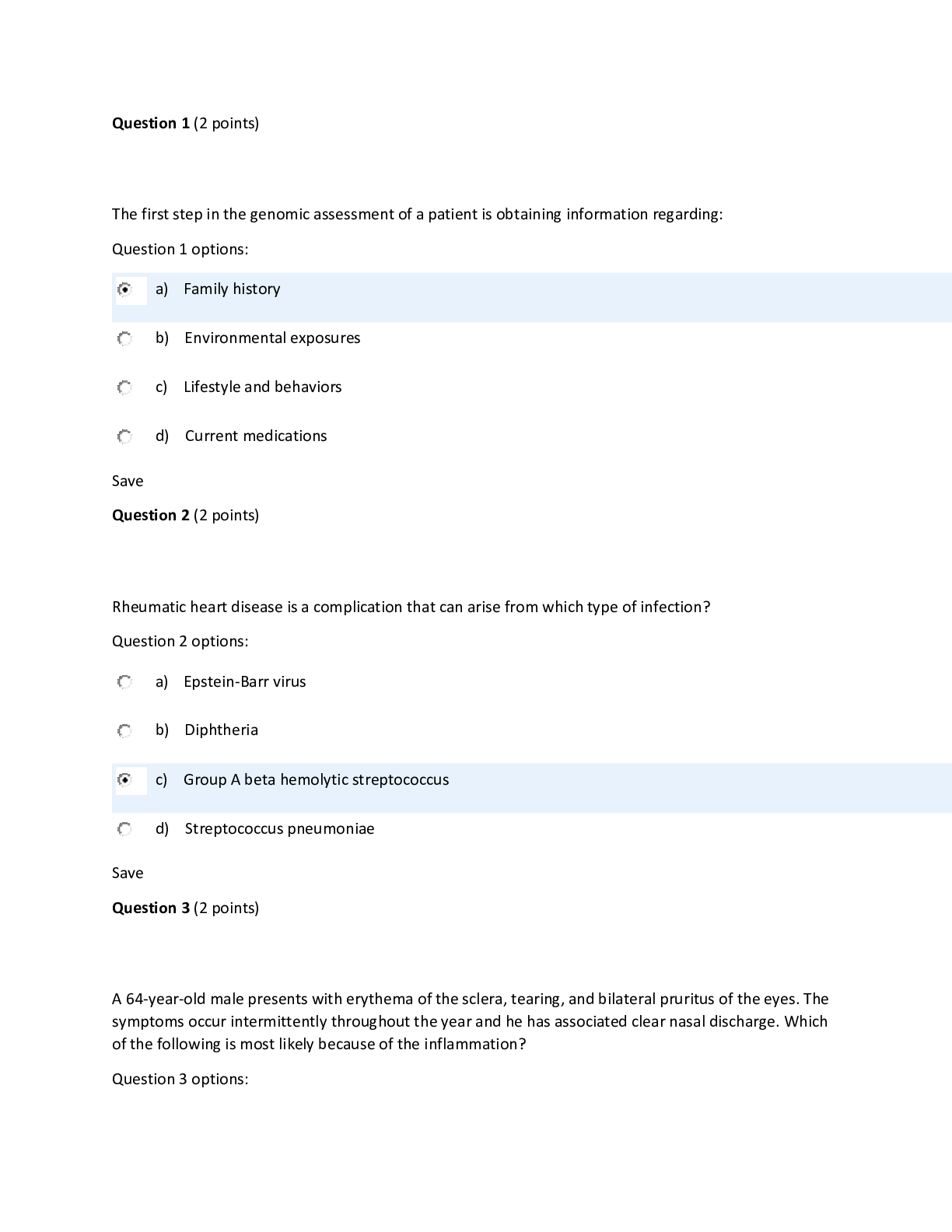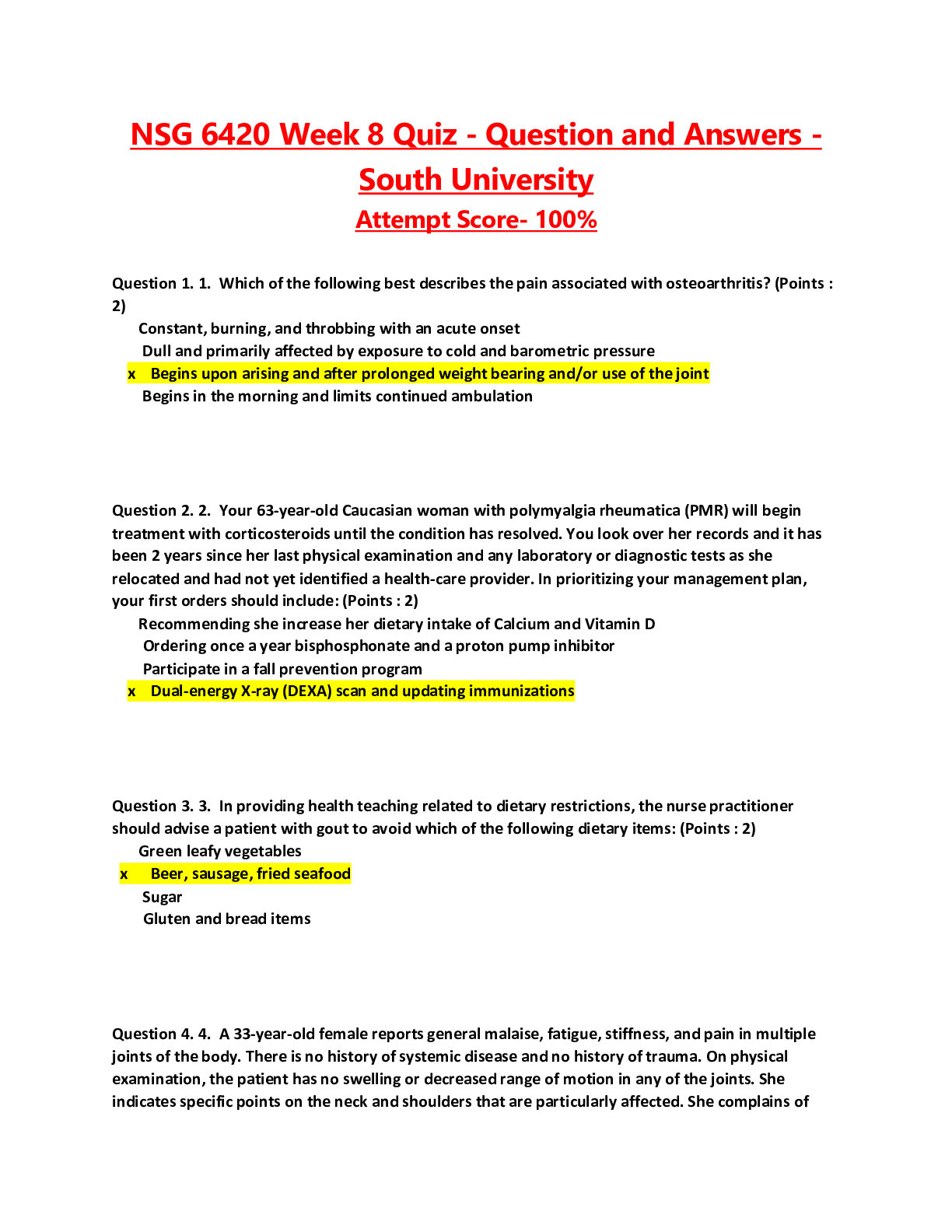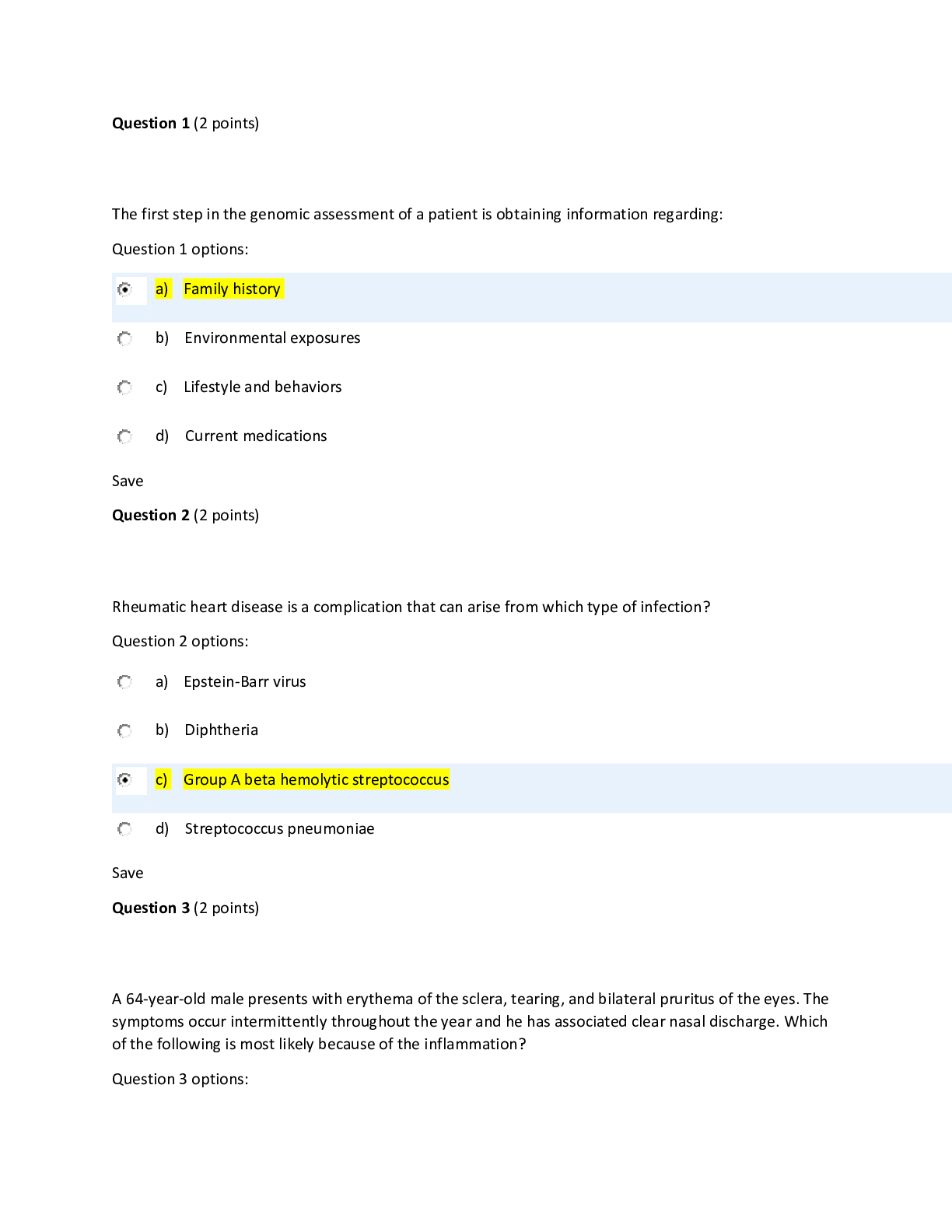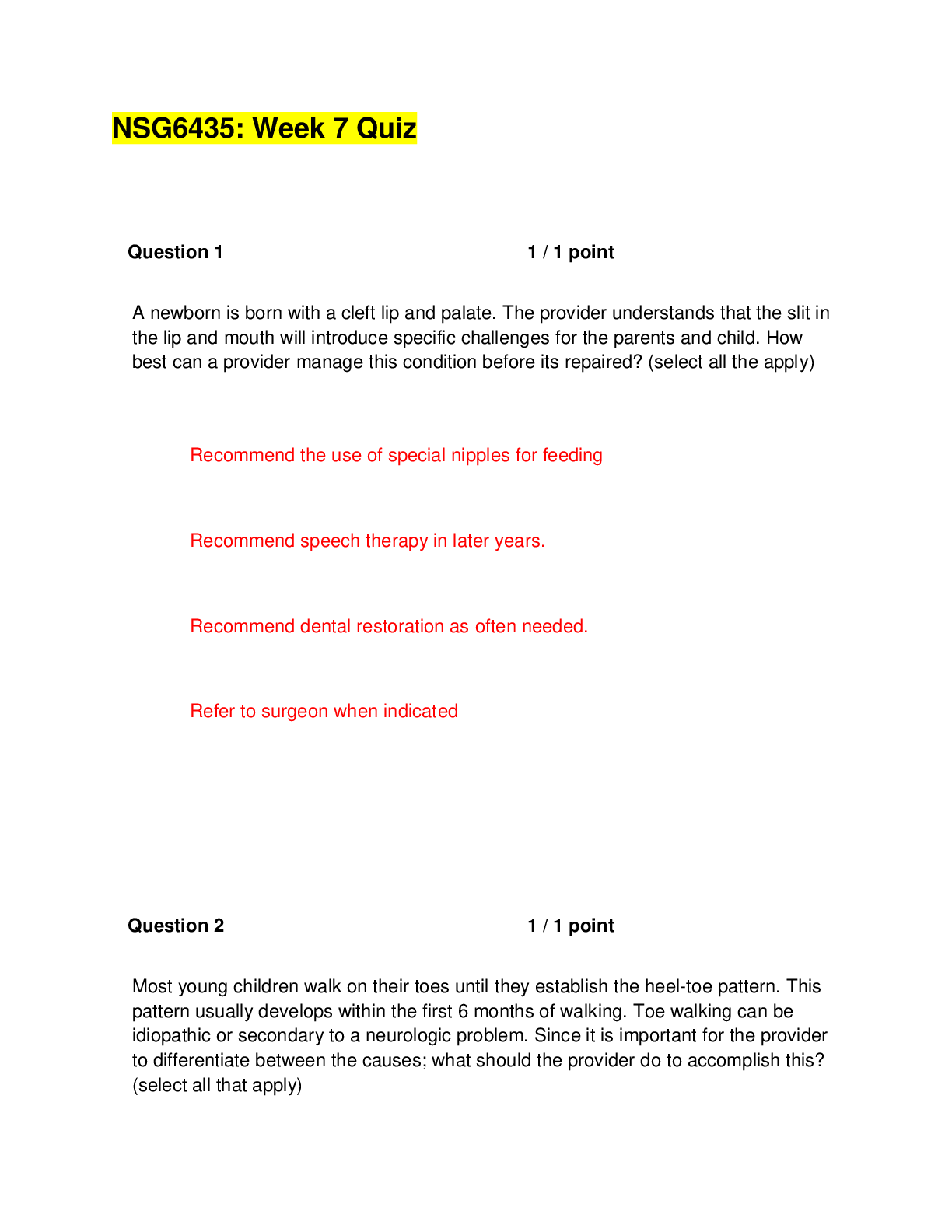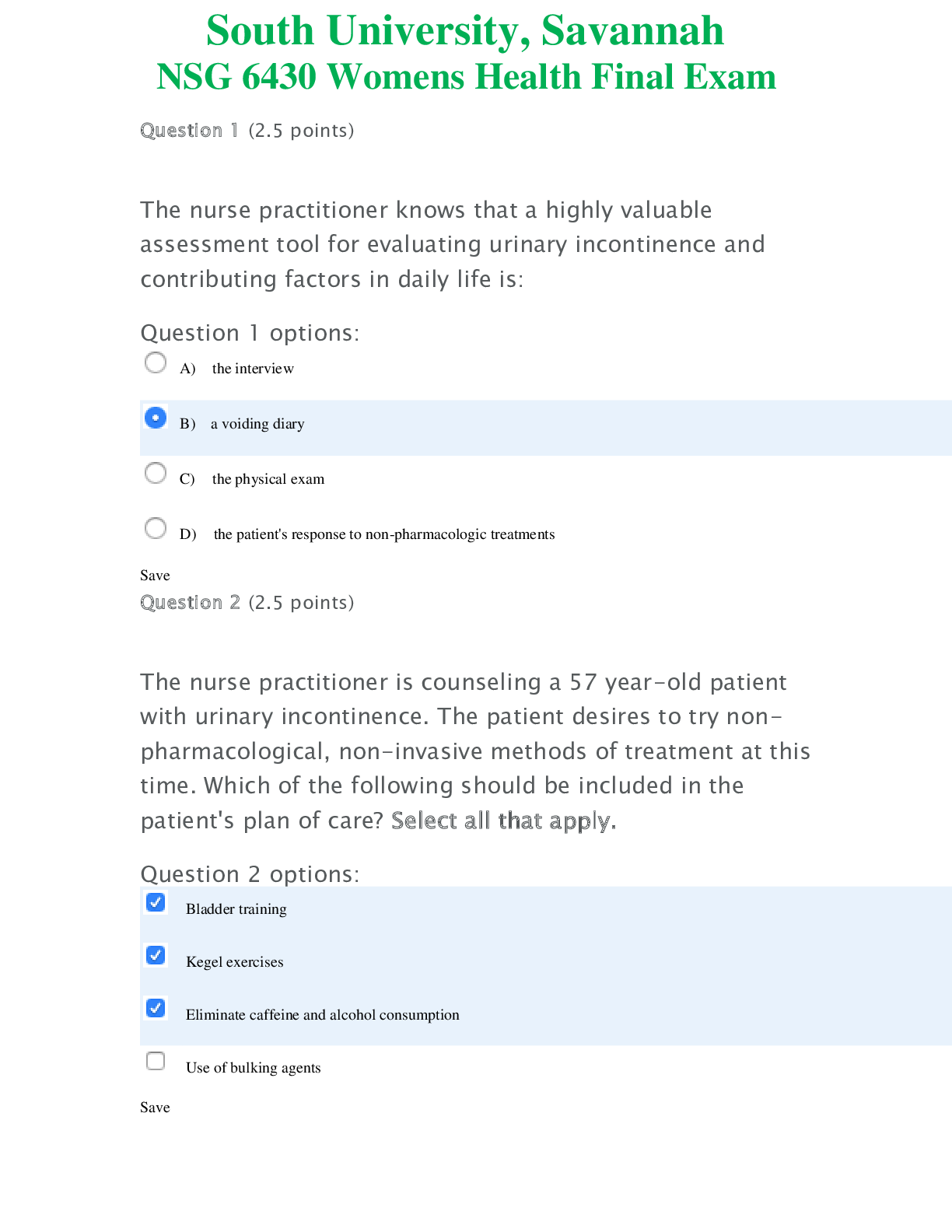*NURSING > EXAM > NSG 6435 Pediatric_Final_study guide 2020 - South University | NSG 6435 Pediatric_Final_study guide (All)
NSG 6435 Pediatric_Final_study guide 2020 - South University | NSG 6435 Pediatric_Final_study guide 2020
Document Content and Description Below
NSG 6435 Pediatric Final Study Guide 2020 - South University Final Exam Study Guide: 1. National Youth Risk Behavior Survey…what is it, what does it do? Look at the list of the top reasons f... or noncompliance for safety. What do people sniff? (glue, aerosol, paint) 2. Early adolescence…how do they feel about themselves? Want to be taken seriously 3. Eating disorders…most common age that these rear their ugly heads? 11-14 years old and research signs and symptoms, behaviors risk factors. 4. Health Guidance re: sexual activity…when would you start this in your practice? 5. Gonorrhea screening in females and males- use urinalysis for males and cervical culture in females 6. HPV screening in females- visual inspection and pap smear 7. Depression and suicide discussion in adolescents…who & what age? Annual screening, researcher “different types of suicide ideation”, risk factors 8. Type I Diabetes…adolescent of what culture and cause Non-Hispanic whites, occur at all ages Type 1 diabetes is caused by autoimmune destruction of pancreatic beta cells in the islets of Langerhans thought to be triggered by a preceding environmental event in genetically susceptible individuals. This destruction of beta cells results in an absolute deficiency in insulin secretion, reduced biologic effectiveness, or both. Normal metabolic function depends upon sufficient amounts of circulating insulin. Insulin deficiency results in uninhibited gluconeogenesis and a blockage in the use and storage of circulating glucose. High blood glucose levels, therefore, are a result of the defective metabolism of carbohydrate, protein, and fats. 21% increase in diabetes was seen over 8 years; the greatest increase was observed in youth diagnosed with type 1 diabetes. Females and males were shown to be affected in equal numbers. The prevalence of type 1 diabetes varied by race and ethnicity and was highest among non-Hispanic white youth (2.55 per 1000 children). Native American children had a much lower prevalence of type 1 diabetes (0.35 per 1000 children), and only 32% of diabetes among Native American children was type 1. Although children were most often diagnosed during the time of puberty, and onset of symptoms can present at any age, the highest age specific increase occurred in youth from the ages of 15 to 19 years old and older Although the onset of type 1 diabetes is gradual with destruction of pancreatic islet cells over time, children may become ill quite suddenly once symptoms manifest. As diabetes develops, the symptomatology reflects the decreasing degree of beta cell mass, increasing insulinopenia and hyperglycemia, and increasing ketoacids. History. With type 1 diabetes, the child may have had a viral infection, cold, or flu; parents may notice increased urination and thirst during the recovery period, with additional signs and symptoms appearing over a period of days or weeks. The following early symptoms are often reported: • Polydipsia • Polyphagia • Polyuria • Nocturia • Blurred vision • Weight loss or poor weight gain • Fatigue • Lethargy • Vaginal moniliasis As ketoacids accumulate, the following history is reported: • Abdominal pain • Nausea, vomiting • Fruity-smelling breath • Weakness (caused by dehydration) • Mental confusion • Coma Approximately 25% of children with new-onset type 1 diabetes present in diabetic ketoacidosis (DKA). Younger age, ethnic minority status, lower socioeconomic status, and lower parent education levels are risk factors for presenting in DKA at diabetes onset; children younger than 2 years old are at the highest risk Urine testing and blood glucose measurements are generally all that are required to make the diagnosis: • Urine for glucose and ketones • Metabolic screen for acid-base status to exclude DKA - - - - - - - - - - - - 1. uncommon. 25. Adolescents and top causes of death- injury, homicide, suicide 26. Diabetes and renal failure 27. Eating Disorders p.159-170 28. Bipolar disease Bipolar disorder, formerly known as manic depression, is characterized by unusual shifts in mood, energy, and functioning and may begin with manic, depressive, or a mixed set of manic and depressive symptoms. The majority of adults with bipolar disorder report their initial symptom was depression, and those who develop symptoms in childhood are significantly more likely to develop severe disease, to be hospitalized frequently, and to have a less favorable life course (Coryell etal, 2013). It is a recurrent disorder, and nearly all of those (90%) who have a single manic episode will have future episodes. Approximately 4% of children younger than age 18 meet the diagnostic criteria for bipolar disorder (Shain and Committee on Adolescence, 2012). The risk of suicide in bipolar depression is the highest of all the psychiatric disorders. A characteristic pattern usually evolves for a particular person, with manic episodes preceding or following major depressive episodes. Most individuals with bipolar disorder return to a full level of functioning between episodes; 20% to 30% experience persistent mood lability and interpersonal difficulties (APA, 2013). Sometimes psychotic symptoms develop after several days or weeks of manic symptoms. Such features tend to predict that the individual with subsequent manic episodes will again experience psychotic symptoms. 378 Multiple theories explain the cause of bipolar disorder, but no definitive cause is known. Imaging studies reveal that there are structural changes commonly found in the third ventricle, the white matter, the prefrontal cortex, the amygdala, and the basal ganglia (Vederine etal, 2011). Genetic factors (specifically, defects on chromosomes 1, 6, 8, and 22) account for almost 60% of bipolar cases. There is evidence of a genetic influence for bipolar disorder from twin studies and adoption studies; bipolar disorder tends to cluster in families. Parents who are bipolar are at greater risk for having bipolar children. Fifty-nine percent of adults with bipolar depression report onset of symptoms during childhood or adolescence, but the onset of symptoms before 10 years old is rare (0.5%) (McClellan etal, 2007). The most common onset of symptoms occurs between 15 and 19 years old. There is no differential incidence based on race, ethnicity, or gender. Children with ADD seem to be vulnerable to bipolar illness, or it may be that ADD is a misdiagnosed early sign of the mania to come. If children are also bipolar, treatment of ADD with psychostimulants or antidepressants may precipitate a manic episode. Antidepressants in depressed children (6 to 12 years old) may also precipitate mania and the onset of bipolar illness 29. Antidepressants 30. Concrete suicidal ideations- greater risk, 31. Suicide and communication- concrete statements 32. What is the no. 1 psychological disorder in the US: anxiety 33. Compulsive disorder: p.195- repetitive physical and mental rituals 34. ADHD and differential diagnoses 35. ADHD in general: familial disorder, symptoms presented prior to 7 years of age 36. ADHD and the DSM-IV-TR… 37. School phobia: absenteeism and academic performance 38. Intussuception- sausage shape mass, pull knees up, abdominal pain, vomiting p.625 39. Molluscum contagiosum- flesh colored papules, p. 409 40. Hirschsprung’s- p.628 41. Headaches- p.759-762 42. GERD and parent education- small frequent thick feeds, lay prone after eating to decrease vomiting 43. Congenital hypothyroidism 44. Positive Galeazzi, Barlow and Ortolani- hip dysplasia 45. Genu Varum- p. 818, bow leg, knocking knees, continues after age 2- refer 46. Peritonsillar abscess- sore throat, fever, unilateral p. 492 47. Infant diet at various ages- 48. PE of the child at various ages 49. Immunizations 50. Secondary hypothyroidism 51. idiopathic thrombocytopenic- p. 919 52. Ventricular septal defect (VSD)- p. 564 Tanner stages- p. 72 Developmental Milestones- p. 110 - When they can feed themselves, head lag, first word, solid foods [Show More]
Last updated: 1 year ago
Preview 1 out of 23 pages
Instant download

Buy this document to get the full access instantly
Instant Download Access after purchase
Add to cartInstant download
Reviews( 0 )
Document information
Connected school, study & course
About the document
Uploaded On
Jun 18, 2020
Number of pages
23
Written in
Additional information
This document has been written for:
Uploaded
Jun 18, 2020
Downloads
0
Views
24













